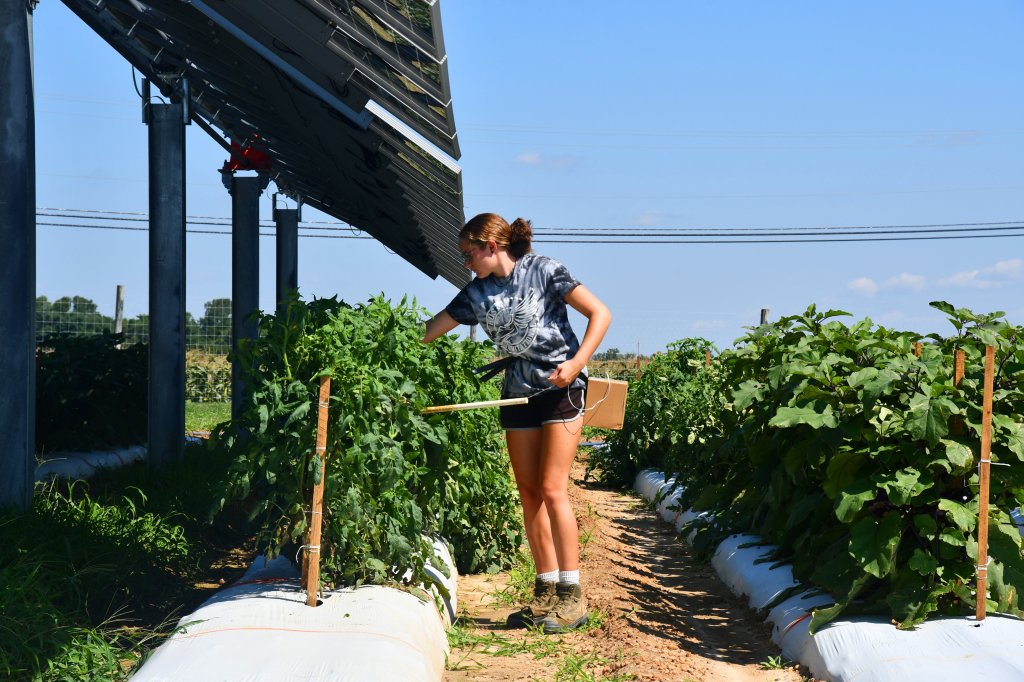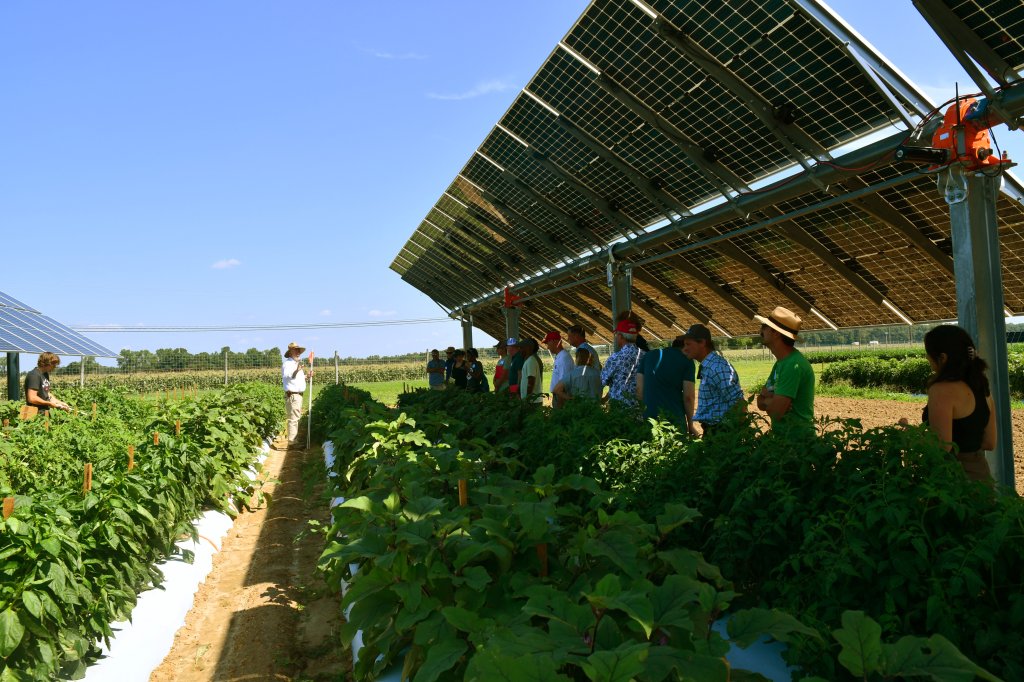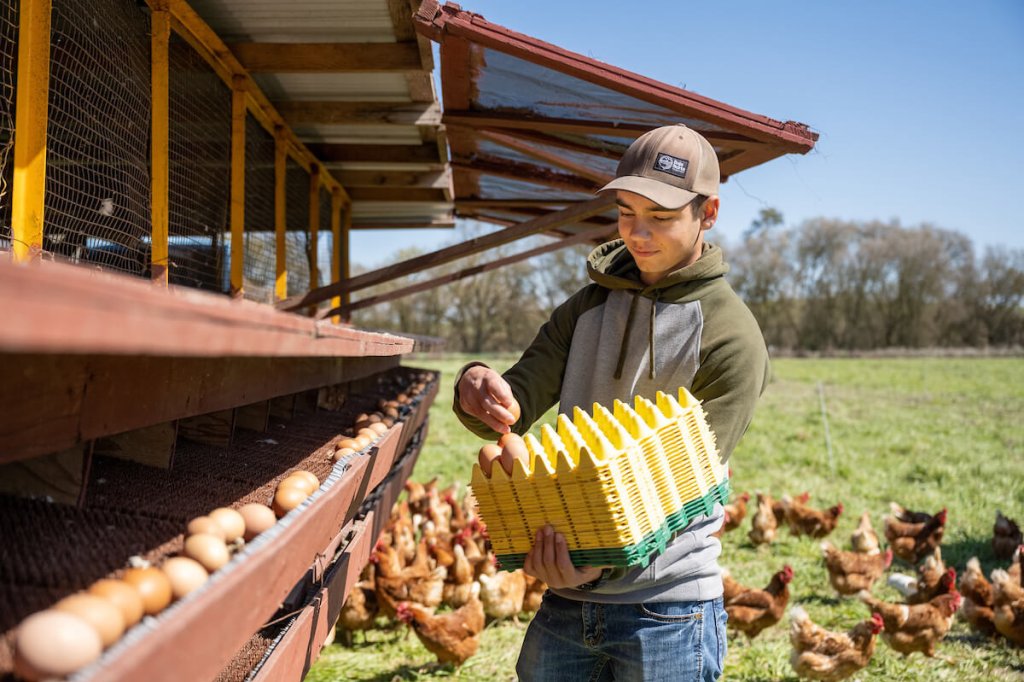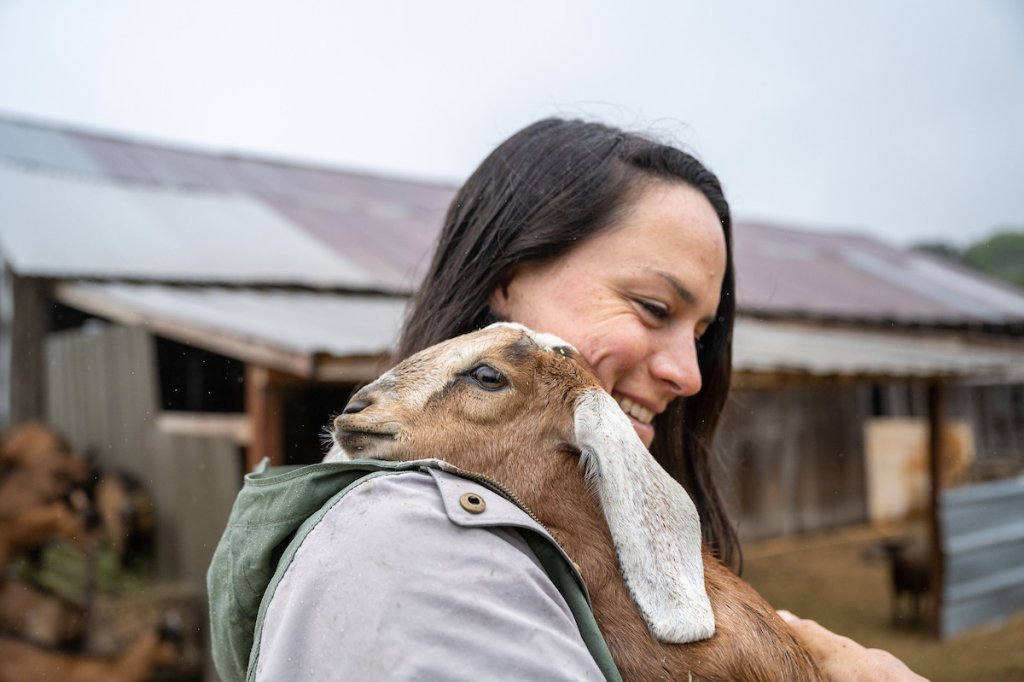The Land Beneath the Panels: How Agrivoltaics Can Transform the Future of Farming
“It’s not the thing you do, but the way you do it,” emphasized Iain Ward, CEO & Founder of Solar Agricultural Services, Inc., as he addressed a room filled with farmers, researchers, and American Farmland Trust (AFT) staff at Rutgers’ Agricultural Research and Extension Center a few weeks ago. His subject? Agrivoltaics.
Going into this day-long training called TAPAS (short for Technical Assistance Program for Agrivoltaics), I didn’t know much about this burgeoning field seeking to combine agriculture with solar energy development. TAPAS? I thought maybe that meant we’d enjoy a spread of small snacks while learning about…solar energy. But after diving into Agrivoltaics 101, discussing land access opportunities, and touring an on-site agrivoltaics operation, I’m convinced this technology will change the future of farming, and I think the farmers around me would’ve agreed.
Let me set the stage: At AFT, we’re working towards a future where solar energy development and agriculture don’t just coexist—they thrive together. Enter agrivoltaics: an innovative approach that allows solar panels and crops to share the same land, offering a lifeline to farmers while advancing clean energy goals. In New Jersey, where both agriculture and solar energy are essential, this dual-use strategy is more than just a concept—it’s becoming a reality.
Why Agrivoltaics in New Jersey?
The push for agrivoltaics in New Jersey is a necessary evolution in how we think about land use. In 2021, New Jersey passed legislation to enable an agrivoltaics program in the state. Around the same time, the state set ambitious clean energy goals, aiming to expand renewable energy sources like solar, which already contributes 7.36% of New Jersey’s electricity. The solar market in the state has seen significant growth, with a 40% decline in solar costs over the past decade and $1 billion invested in 2023 alone.
New Jersey is ranked 10th in the country for total installed solar capacity, with projects like the Ben Moreel Solar Farm, which powers nearly 5,000 homes. As demand for solar continues to rise, the potential for agrivoltaics to help meet clean energy targets is enormous. The dual-use approach behind agrivoltaics also opens up new opportunities for farmers and rural communities to benefit from these clean energy investments.
These opportunities may also prove essential to keeping New Jersey’s 10,000 remaining farms in production. While agriculture has long been part of the fabric of the Garden State, New Jersey is the most densely populated state in the nation, leading to increased pressure on farmers to sell off their land for houses, warehouses, industrial sites, and yes, traditional solar development. However, agrivoltaics can allow farm families to diversify their revenue streams, allowing farmers to keep their operations in business instead of having to sell generations of farming legacy off to the highest bidder.
Smart Solar℠: A Roadmap to Thriving Farms and Abundant Clean Energy
The Department of Energy estimates that 10 million acres (about twice the area of New Jersey) of land will be needed by 2050 to meet the nation’s renewable energy generation goals. Farmland—with its relatively flat, cleared fields and proximity to electric infrastructure—often makes an attractive site for new solar developments. Many observers view solar and agriculture as competitors for the same product: land. But does it have to be that way?
At AFT, we launched our Smart Solar initiative in 2021 to build a different future. Our vision is for solar energy to grow while creating new and innovative opportunities for farmers and ranchers to build long-term viability. AFT’s Smart Solar initiative seeks to build consensus and find solutions that allow for solar energy generation and agriculture to thrive together. Training the next generation of agrivoltaic enthusiasts is a key step in bringing this vision to life.
Leading the Way Through Technical Assistance and Farmer Training
While there is this huge opportunity to farm under solar arrays, there remains a gap in the technical assistance, training, and education needed to make this technology accessible. Building on our long history of working with farmers, AFT saw an opportunity alongside Rutgers University, a key player in New Jersey’s agricultural research, to bridge this gap. Together, we secured a grant from the U.S. Department of Energy through the Foundational Agrivoltaic Research at Megawatt Scale program (FARMS) to launch the Technical Assistance Program for Agrivoltaics Systems (TAPAS). This program is designed to educate a diverse cohort of farmers on agrivoltaic applications and funding opportunities while demonstrating how these technologies can play a part in the future context of what it means to be a successful producer in New Jersey.
“This was the beginning of a network of thoughtful people trying to do [agrivoltaics] the right way,” said Ethan Winter, AFT’s National Smart Solar Director. “We’re not looking for loopholes, we’re really trying to do something innovative and necessary for the Garden State.”
“This was the beginning of a network of thoughtful people trying to do [agrivoltaics] the right way,” said Ethan Winter, AFT’s National Smart Solar Director. “We’re not looking for loopholes, we’re really trying to do something innovative and necessary for the Garden State.”
Our goal is clear: to help farmers integrate solar energy into their operations in a way that enhances their viability, sustains their land, and contributes to the state’s clean energy goals. We’re partnering in these trainings because this is AFT’s area of expertise: working with farmers and taking a skills-based approach to teaching and learning that focuses on what people need to do as a result of a learning experience, not just on what they need to know.
Leading these training sessions is Christina Couch, AFT’s New Jersey Technical Specialist. She is deeply committed to supporting farmers in this journey. As a first-generation farmer herself, cultivating vegetables, herbs, and edible flowers at Pura Farms, Christina brings a unique perspective. Her approach is rooted in a deep understanding of what farmers truly need. She emphasizes practical, skills-based learning that equips farmers to navigate the complexities of agrivoltaics, from securing funding to managing solar arrays on their land.
One of the key challenges Christina highlights is the gap in technical assistance available to farmers. Often, new programs and funding opportunities are introduced without sufficient guidance on how to apply or implement them. AFT aims to fill this gap, ensuring that farmers are not only aware of the opportunities agrivoltaics offers but are also prepared to take full advantage of them.
“The beauty of this program,” Christina shared, “is to hopefully help farmers along the way and make sure they’re advocating for themselves, especially when we’re working with developers. There’s a history of developers taking advantage of farmers or landowners, coming in, building something, and then abandoning it. It’s important that we get farmers out in person to see if [agrivoltaics] is what we’re saying or hoping it’s going to be. The only way to get them over that hump of skepticism is to have them physically there, see the operation happening, and being super transparent about every blip along the way, financially or construction wise.”
We just want people to succeed. I don’t want to see anyone go into this and get taken advantage of by someone who’s going to sell them a project and pass it off to the next person.
The Future of Agrivoltaics
This summer marked the beginning of our piloting phase. A key reason for doing this is to test what works and what doesn’t for farmers before rolling out the full TAPAS initiative. “You really need to listen to the farmers in your community and understand what they need before you try to push anything onto them,” emphasizes Christina. “I’m happy we did this training pilot small-scale. As we move into next year and the following year, we hope to have 30 farmers and more of a reach and more consistency, because a one-off session is really just an introductory seminar. If we want to train farmer experts in agrivoltaics, that will require multiple weeks of consistent learning and checking in over time.”
As we continue to develop the TAPAS program, Christina and Iain Ward are working on creating a comprehensive curriculum to train farmers as agrivoltaics experts. We’re also committed to providing continuous resources, from fact sheets to hands-on guidance, ensuring farmers have support every step of the way. Our vision is to create a template in New Jersey that other states can adopt, influencing policy and expanding the reach of agrivoltaics nationwide.
We’re already seeing progress at the federal level with the introduction of the Protecting Future Farmland Act of 2023 by Sen. Baldwin (D-WI) and Sen. Grassley (R-IA). This bill directs the USDA to support smart solar projects, ensure that land converted to solar can be returned to agricultural use, and promote the growth of agrivoltaics.
“We hope this collaboration can serve as a model for connecting agrivoltaics research, policy, and farmer technical assistance, leading to new opportunities for land access and creating generational agricultural enterprises,” shared Ethan Winter.
If you’re a farmer or rancher interested in learning more about agrivoltaics, check out these resources below or reach out to us directly by contacting one of our Smart Solar staff members:








